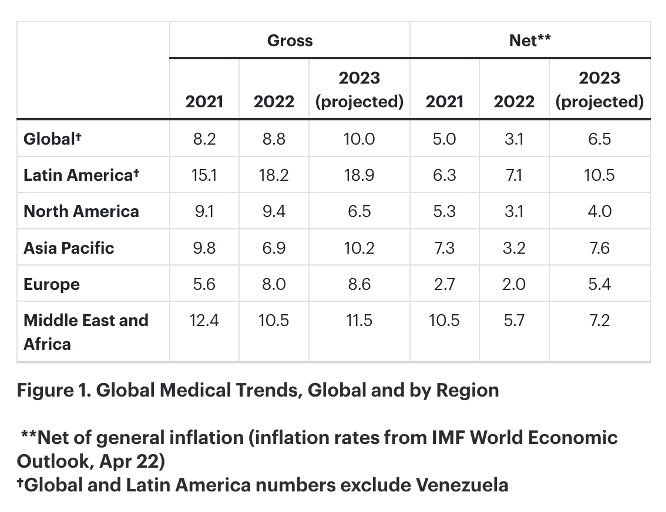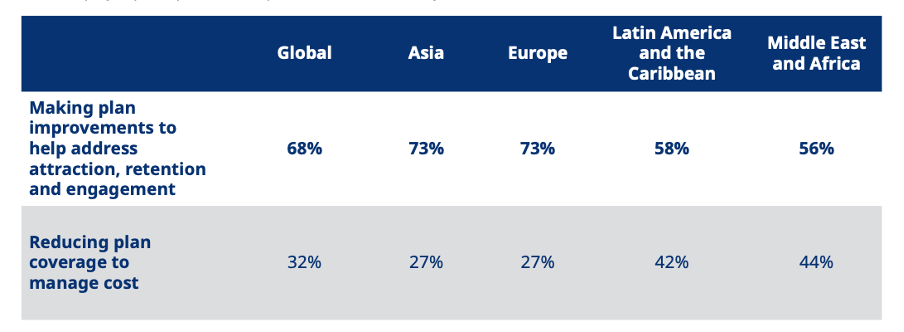Small and medium enterprises (SMEs) across sectors and geographies have proven their agility and adaptability in the face of the biggest pandemic in living history, pivoting business models and delivery methods to keep them afloat in the face of increased public restrictions. Three years after adapting to significant business disruption, many markets worldwide are witnessing price increases in business health insurance, a trend that appears to be more prevalent for SMEs.
Medical costs on the rise
Healthcare costs are on the rise in most regions. Over the next three years, more than three-quarters of health insurers (78 per cent) expect greater or significantly higher medical trends. During this time frame, 84 per cent of insurers in Europe, 73 per cent in Asia-Pacific, 69 per cent in Latin America, and 60 per cent in the Middle East and Africa anticipate a higher or significantly higher uptick in medical expenditure.
This global pattern of medical inflation (an increase in per-unit costs for the same service) is expected to continue well past 2023. According to recent projections, the Asia Pacific region is expected to witness the highest jump in medical inflation, projected to rise from 6.9 per cent to 10.2 per cent. Latin America (18.2 per cent to 18.9 per cent) and the Middle East (10.5 per cent to 11.5 per cent) are projected to see a modest increase in costs. Europe has historically experienced lower levels of cost increase but is now also expected to face a record cost increase from 5.6 per cent to 8.6 per cent.

North America is the only region experiencing a decline in its anticipated figures, with a drop from 9.4 per cent to 6.5 per cent projected for 2023. Although inflation is expected to decrease in 2023, US employers are still apprehensive about cost and volatility and have not yet experienced the positive effects. The high cost of new medical technologies and providers’ desire for higher profit margins continue to have a significant impact on medical expenses. Insurers also point to broader concerns that influence these costs, including the reduction in the quality and funding of public health systems and geopolitical crises.
High healthcare insurance dampens SME growth
A US-based study of the small business health insurance market reveals that 95 per cent of SME owners have seen the cost of health insurance increase over the past four years, and 56 per cent estimate the yearly increase in healthcare costs to be 10 per cent or higher. When asked how the rising cost of health insurance impacts their business, the surveyed SME owners cite that they have had to pass the cost on to their customers by increasing prices for their products and services. They also find the rising cost of health insurance is affecting their competitiveness in talent attraction and causing them to delay growth plans like purchasing key equipment. Thirty-seven per cent of respondents said they do not offer health insurance because the costs are too high.
Compared to medical plan expense management or containment, 68 per cent of insurers surveyed by Mercer worldwide predicted that employers will prioritise plan enhancements that address employee attraction, retention, and engagement. Insurers estimate that internationally, less than one-third (32 per cent) of plan sponsors will lower coverage to cut costs. This perspective is most likely influenced by larger trends in the workplace, such as the lack of talent, the changing nature of the workforce, and shifting employee expectations.
Countering medical inflation
Medical inflation affects SMEs more acutely than larger organisations. Unlike larger companies, SMEs lack the benefits of a larger pool of insured employees, greater bargaining power with health insurance providers, and the support of full-time human resources personnel. As a result, these businesses are often left with limited options when faced with increased health insurance premiums.
Analytics firm GlobalData notes that the health of the SME insurance market is dependent on the number of SMEs in each country, so if liquidations start to rise, then the number and value of insurance contracts will decline. SMEs that do survive will have to drastically cut their costs, which may include insurance coverage. Considering that globally 90 per cent of all businesses are SMEs and account for 50 per cent of all jobs, this could have far-reaching consequences for the wider economy.
In Europe, the cost-of-living crisis is showing no signs of coming to an end, with continuing geopolitical uncertainty, inflation, and energy prices still sky high, says Ben Carey-Evans, Senior Insurance Analyst at GlobalData. “On top of rising inflation, consumers are facing higher mortgage rates, which will impact both homeowners and renters as landlords will be likely to raise rents. Therefore, consumers will have less disposable income to spend, which will further impact SMEs.”
Insurance companies may have to prioritise customer retention, even if it means a temporary decrease in profits. A short-term fix might be to offer adaptable insurance to keep clients on board. As the COVID-19 pandemic continues to pose significant challenges for businesses, there is growing interest in the potential return of payment holidays and flexible payment terms. These measures were widely used during the initial outbreak, and many experts believe they could once again prove valuable in supporting struggling enterprises. Insurers may have found a better solution to prevent customers from leaving altogether by allowing customers to toggle specific policies on and off so they can manage their payments more effectively. “It will be a tough year for insurers in the SME market, with the level of concern extremely high. Insurers that can stand out by offering innovative products, such as on-demand insurance — or at least communicate well with clients — will be most likely to complete increasingly difficult renewals,” Carey-Evans adds.
In the Middle East, Abu Dhabi’s recent flexible health insurance programme for entrepreneurs and investors demonstrates a potentially replicable model for the globally underserved SME segment of the insurance market. In response to the rising needs of the market and to elevate the emirate’s position as an attractive destination, the new insurance options extend to investors and holders of free business licenses, their families, and their employees for the costs of treatment services amounting to Dh150,000 annually. “Initiatives such as the flexible health insurance, ease the burden on businesses, especially startups, as they join the business world,” said Hala Khaled Al Ameri, Executive Director of the Competitiveness Office of Abu Dhabi (COAD) at the ADDED in a statement.

Other insurance features include 100 per cent emergency coverage, a 20 per cent co-pay of the cost of all outpatient treatment services, and a 30 per cent co-pay for medications. The programme also offers the possibility of upgrading insurance coverage according to the patient’s needs. The feasibility of this model globally remains to be seen, as factors affecting access to affordable health insurance for SMEs can vary across different regions and healthcare systems.
This article appears in Omnia Health magazine. Read the full issue online today
Connect with lab and healthcare manufacturers and suppliers at Medlab Asia and Asia Health from August 16 - 18. Register here.


